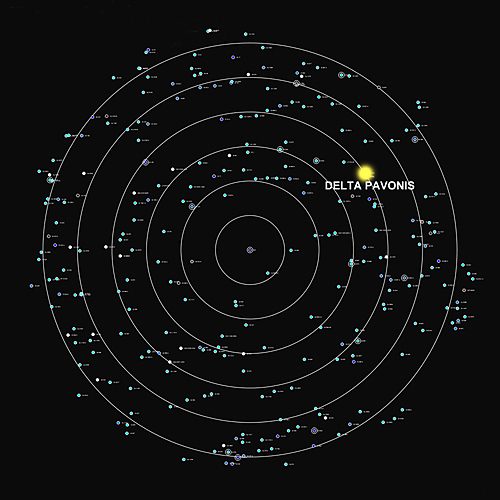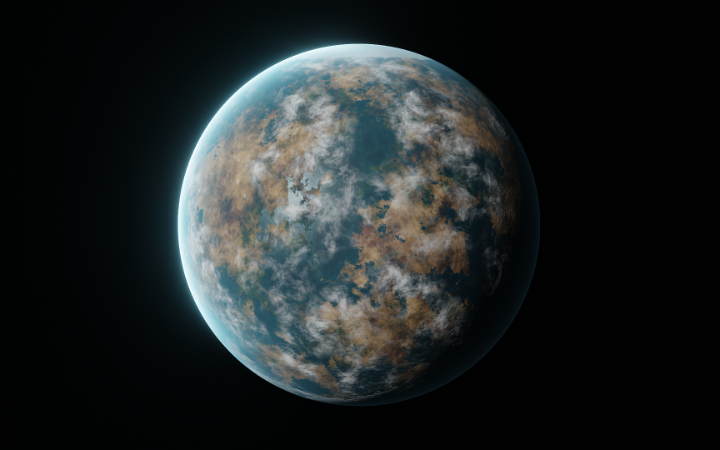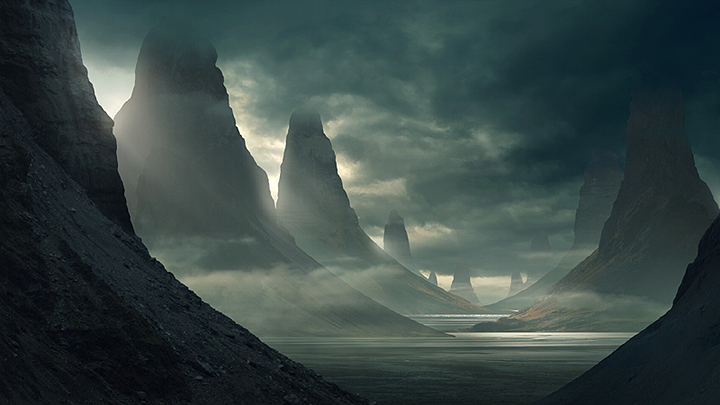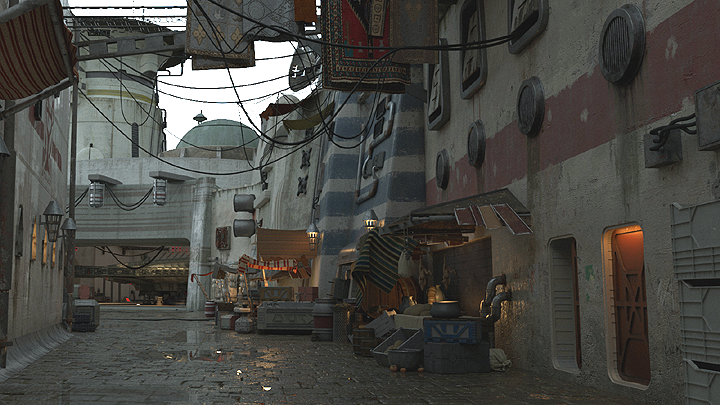
DISTANCE: 19.9 light years from Sol
NEIGHBORING SYSTEMS: Beta Hydri 9.3 lys Alpha Centauri 16.5 lys Gliese 876 17.7 lys
DELTA PAVONIS is a yellow-orange dwarf with five planets in orbit that includes three small rocky worlds and two large gas giants. There are also two separate asteroid fields; the first of which is located in close proximity to its host star and consists of dense metals and rocky debris. The secondary asteroid field orbits in the outer regions between the two gas giants and is comprised of silicate dust and large chunks of frozen water-ice. This star is believed to be transitioning into a subgiant as it begins to fuse the increasing amounts of helium ash mixed with hydrogen at its core. It has over twice the amount of heavy elements as Sol and the entire region contains large amounts of Caladanium ore.
FUSANG is the third planet in orbit and slightly more massive than Earth, making it’s gravity 1.2 standard Gs. The landscape is predominantly comprised of widespread mountain ranges, mineral-rich grasslands, and rocky terrain. Oceans cover nearly 65 percent of its surface with extensive rivers and tributaries that branch out across all the major continents. Elevated levels of ozone in the atmosphere, combined with low concentrations of methane and carbon dioxide, contribute to the overall cooler temperatures on this bleak and desolate world. Seasonal changes typically alternate between short frigid winters with heavy snowfall and long rainy summers during which even equatorial temperatures only reach around 16 C. Fusang’s two large moons, Lada and Lado, help to balance the planet’s axis while, simultaneously, causing routine intervals of seismic activity.
Indigenous animal life is sparsely populated, yet there is a unique assortment of mammals, birds, reptiles, insects, and fish that have all evolved on this world.

By the end of the 22nd century, most of the Human colonies had declared their own independence and officially separated themselves from the United Earth Conglomerate. Because of this, a large percentage of Earth’s reliable assets were greatly diminished and the UEC began a desperate search for new star systems to replace its lost resources. In 2202, the Zarkov Corporation confirmed the discovery of a habitable planet located in the Delta Pavonis star system. Continuing its long-standing partnership with the Lao Che Syndicate, the two corporations combined their efforts once again to colonize this distant world. Not only was the entire region enriched with valuable resources, but establishing a permanent settlement in this system was a significant opportunity to expand Earth’s corporate jurisdiction.
As two of the most steadfast members of the UEC, the Zarkov Corporation and the Lao Che Syndicate were given a great deal of latitude in the development of this colony. Employees of both companies, and their families, first settled on Fusang in a region just north of the equator where they established a joint community called Opona Gorod. This city quickly became the official hub for off-world commerce and was divided into two separate districts. The Western Quarter not only served as the residential area for the Russian colonists, but also became the headquarters for their mining operations. The Eastern Quarter was set aside for the Chinese colonists where they focused primarily on manufacturing and agriculture. The urban center, which connected the two districts, was allocated specifically for cooperative markets and local businesses to bring both groups together.
Nearly every individual who has immigrated to this world has been assigned a particular function for the purpose of supporting the society as a whole. Most of those employed by the Zarkov Corporation are involved in the numerous mining projects throughout the system. This includes the extraction of various metals from the planet itself and its two moons, as well as mining radioactive ore from the innermost asteroid field. These resources then go through a detailed refinement process before being utilized by the colony itself or sold off-world as valuable commodities. Although the Lao Che Syndicate has a much larger labor force and occasionally assists in these mining operations, most of their employees are farmers and factory workers. They have developed an extensive agricultural system using the planet’s dark, rich soil to grow wheat, barley, corn, soybeans, cotton, rice, and even an assortment of vegetables. They also manufacture a variety of industrial products such as building materials and even small spacecraft for the colony’s increasing needs.

Most of the additional supplies this colony receives comes from their corporate benefactors who had previously colonized the Epsilon Indi system as well. Yet, it is important to note that, although these two companies experienced great success in their earlier endeavor, the individuals employed by them had never shared the same planet before. With an entire new world for the taking, they could have chosen to establish their own isolated settlements apart from each other, but their initial decision was based on the belief that they would work together as a means of mutual support. It didn’t take long for their drastic cultural differences to lead to recurrent confrontations and conflict. Even now, ongoing tensions between the two societies remain high and occasionally require the UEC to intervene.
While several community leaders on Fusang have achieved powerful positions in their society due to their legitimate business ventures, most of them have reached that point by participating in the elicitation of bribes, financial extortion, black market dealings, and even Human trafficking. This planet has also become the undisclosed headquarters of organized piracy in this quadrant and, because of its isolated location, is less beset by constant scrutiny. Although neither the Zarkov Corporation nor the Lao Che Syndicate would ever officially admit to having any involvement in such activities, both companies have been accused of contracting covert raids on other corporations in the past. The average resident of this colony would also never openly share information on this matter out of fear of reprisal against themselves and their families.
According to the official census of 2233, nearly all of Fusang’s 30,000 colonists reside within the walls of Opona Gorod with only a few small groups of fishing and hunting outposts located outside of the perimeter. Aside from the scheduled layovers by interstellar merchants and the routine inspections made by corporate officials, this system is far too remote to receive many visitors. Those who do come to this world are often treated with suspicion and apprehension. Yet, a few more progressive entrepreneurs have established a wide range of entertainment venues such as bars, casinos, and private brothels as a means of bringing in extra revenue from tourists who truly want to get away from it all.

At nearly 20 light years away from Earth, this star system held the distinction of hosting the most distant Human settlement for ten years prior to the subsequent colonization of Kappa Ceti. To this day, it continues to remain the furthest colony that has ever been incorporated into the UEC.